Management Accounting Tutorial - Finance Assignment Solution
VerifiedAdded on 2023/01/06
|13
|1981
|76
Homework Assignment
AI Summary
This document provides a comprehensive solution to a management accounting tutorial, addressing key concepts and calculations. It begins by analyzing cost behavior using the high-low method, distinguishing between fixed and variable costs, and formulating cost functions. The solution then delves into predetermined overhead rates, calculating and applying manufacturing overhead. Further analysis includes process costing, determining equivalent units of production, cost per equivalent unit, and work-in-process inventory valuation. The document also covers standard costing and variance analysis, computing direct material and labor variances. Break-even analysis is performed, calculating break-even points in units and dollars, and determining the margin of safety, along with an assessment of how changes in cost structures affect the break-even point. Finally, the solution concludes with a financial analysis of different product models, determining contribution margins, and providing recommendations based on the financial outcomes.
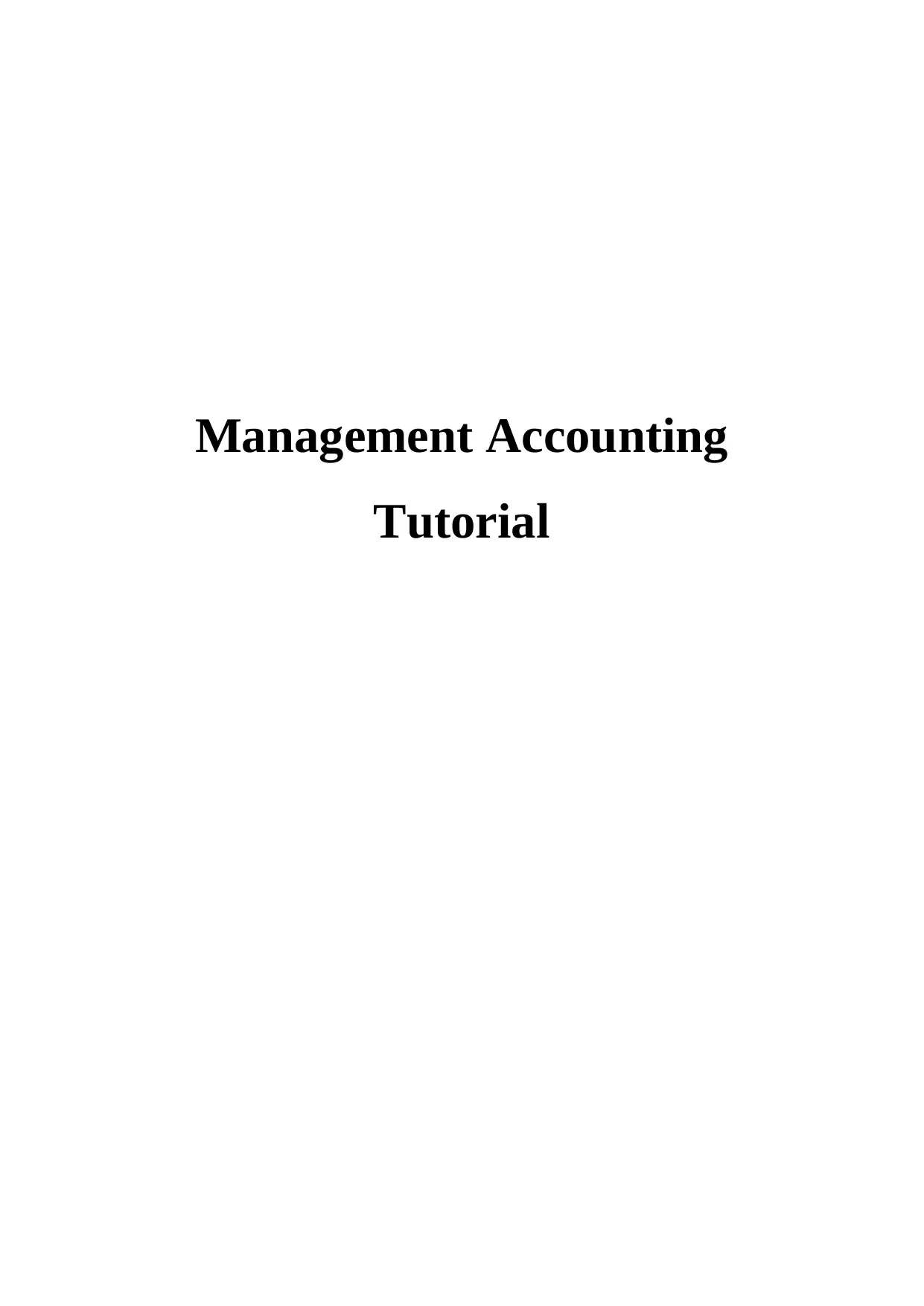
Management Accounting
Tutorial
Tutorial
Paraphrase This Document
Need a fresh take? Get an instant paraphrase of this document with our AI Paraphraser
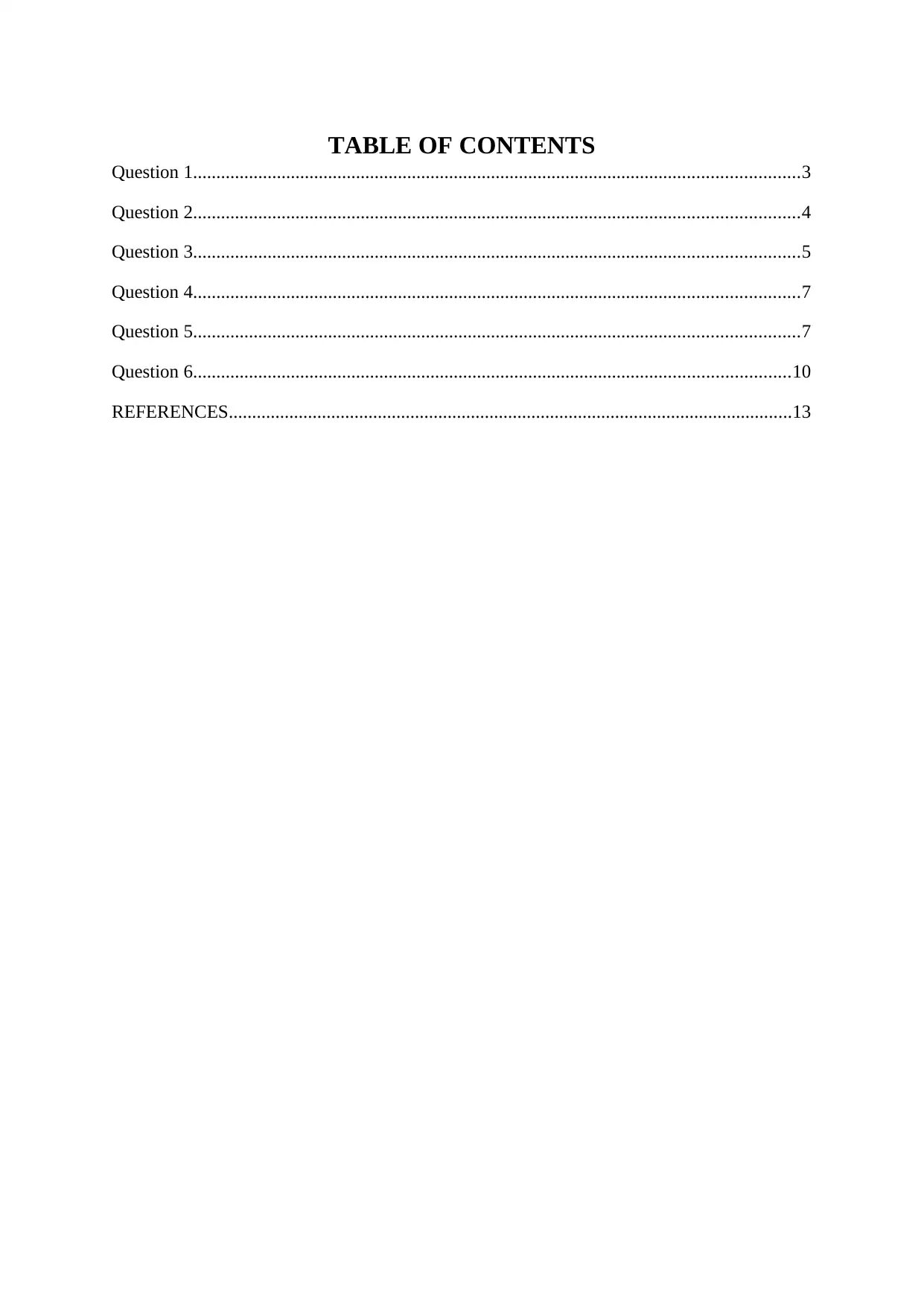
TABLE OF CONTENTS
Question 1..................................................................................................................................3
Question 2..................................................................................................................................4
Question 3..................................................................................................................................5
Question 4..................................................................................................................................7
Question 5..................................................................................................................................7
Question 6................................................................................................................................10
REFERENCES.........................................................................................................................13
Question 1..................................................................................................................................3
Question 2..................................................................................................................................4
Question 3..................................................................................................................................5
Question 4..................................................................................................................................7
Question 5..................................................................................................................................7
Question 6................................................................................................................................10
REFERENCES.........................................................................................................................13
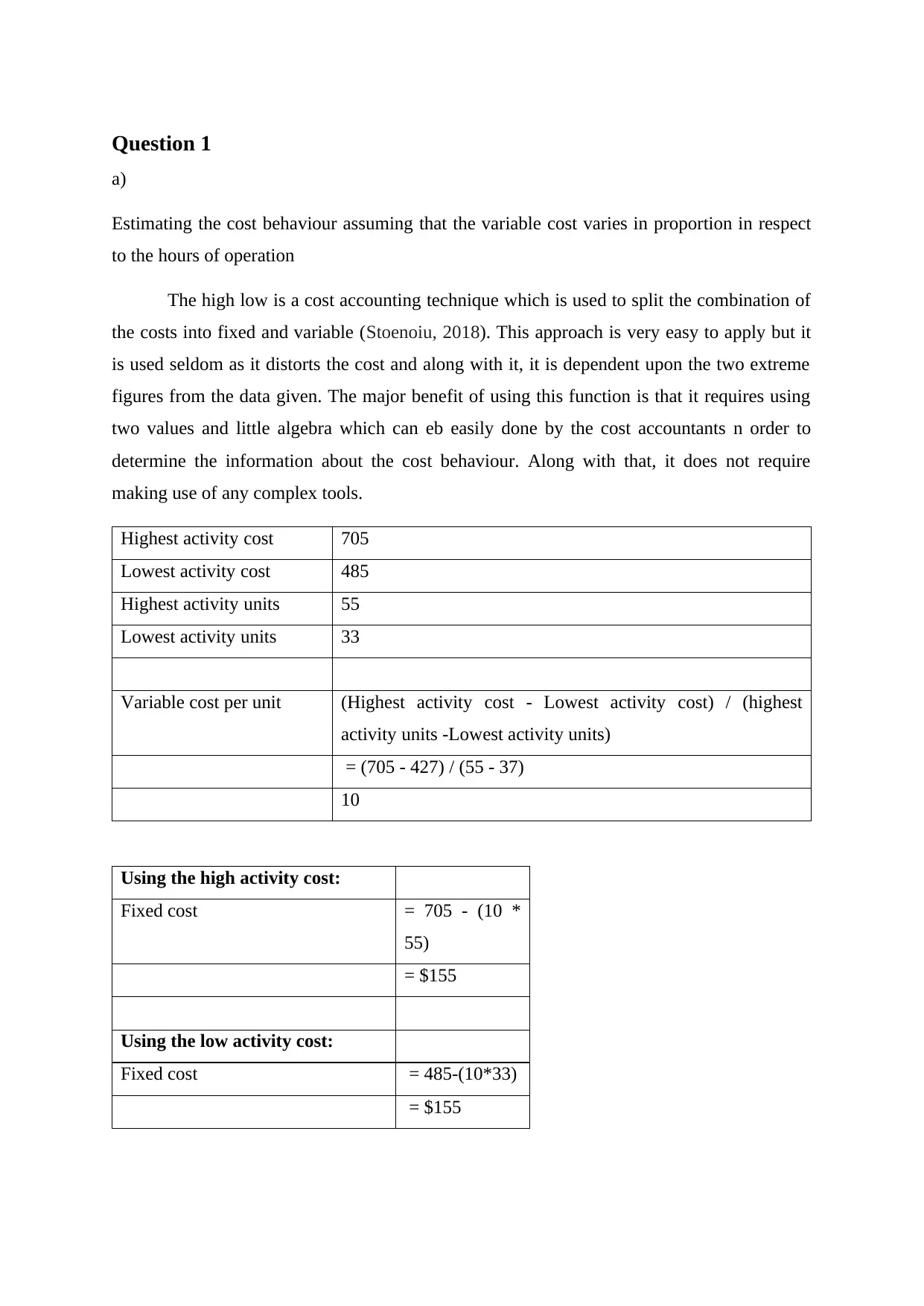
Question 1
a)
Estimating the cost behaviour assuming that the variable cost varies in proportion in respect
to the hours of operation
The high low is a cost accounting technique which is used to split the combination of
the costs into fixed and variable (Stoenoiu, 2018). This approach is very easy to apply but it
is used seldom as it distorts the cost and along with it, it is dependent upon the two extreme
figures from the data given. The major benefit of using this function is that it requires using
two values and little algebra which can eb easily done by the cost accountants n order to
determine the information about the cost behaviour. Along with that, it does not require
making use of any complex tools.
Highest activity cost 705
Lowest activity cost 485
Highest activity units 55
Lowest activity units 33
Variable cost per unit (Highest activity cost - Lowest activity cost) / (highest
activity units -Lowest activity units)
= (705 - 427) / (55 - 37)
10
Using the high activity cost:
Fixed cost = 705 - (10 *
55)
= $155
Using the low activity cost:
Fixed cost = 485-(10*33)
= $155
a)
Estimating the cost behaviour assuming that the variable cost varies in proportion in respect
to the hours of operation
The high low is a cost accounting technique which is used to split the combination of
the costs into fixed and variable (Stoenoiu, 2018). This approach is very easy to apply but it
is used seldom as it distorts the cost and along with it, it is dependent upon the two extreme
figures from the data given. The major benefit of using this function is that it requires using
two values and little algebra which can eb easily done by the cost accountants n order to
determine the information about the cost behaviour. Along with that, it does not require
making use of any complex tools.
Highest activity cost 705
Lowest activity cost 485
Highest activity units 55
Lowest activity units 33
Variable cost per unit (Highest activity cost - Lowest activity cost) / (highest
activity units -Lowest activity units)
= (705 - 427) / (55 - 37)
10
Using the high activity cost:
Fixed cost = 705 - (10 *
55)
= $155
Using the low activity cost:
Fixed cost = 485-(10*33)
= $155
⊘ This is a preview!⊘
Do you want full access?
Subscribe today to unlock all pages.

Trusted by 1+ million students worldwide

Expressing the cost behaviour in a cost function (Y = a + bX)
Total cost = 155 + b (10)
Where Y = Total cost, a = Fixed cost, b = Operating hours, X = Variable cost per unit
b)
Computing the total utilities cost for 45 hours in next week
Total utilities cost = 155 + (45 *10) = $605
Question 2
a)
Computation of company’s predetermined overhead rate for the year
The predetermined overhead rate is mainly applicable to the manufacturing overhead
in association with the product order and is determined at the beginning of the year (Abu,
Jamaludin and Zakaria, 2017). It is calculated by dividing the budgeted manufacturing o/h
cost by the allocation base which can be labour hours, machine hours and so forth.
Formula is, predetermined overhead rate = Budgeted manufacturing overhead / budgeted
machine hours
= $300000/$40000
= $7.5 per machine hour
b)
Determining how much manufacturing overhead applied to production during January
Applied manufacturing overhead = (Machine hours used) * (predetermined overhead rate)
= (1600+2400+1000) * $7.5 per hour
= $37500
c)
Calculating the overapplied or underapplied overhead for the month of January
Overapplied overhead = Actual overhead – Applied overhead
Total cost = 155 + b (10)
Where Y = Total cost, a = Fixed cost, b = Operating hours, X = Variable cost per unit
b)
Computing the total utilities cost for 45 hours in next week
Total utilities cost = 155 + (45 *10) = $605
Question 2
a)
Computation of company’s predetermined overhead rate for the year
The predetermined overhead rate is mainly applicable to the manufacturing overhead
in association with the product order and is determined at the beginning of the year (Abu,
Jamaludin and Zakaria, 2017). It is calculated by dividing the budgeted manufacturing o/h
cost by the allocation base which can be labour hours, machine hours and so forth.
Formula is, predetermined overhead rate = Budgeted manufacturing overhead / budgeted
machine hours
= $300000/$40000
= $7.5 per machine hour
b)
Determining how much manufacturing overhead applied to production during January
Applied manufacturing overhead = (Machine hours used) * (predetermined overhead rate)
= (1600+2400+1000) * $7.5 per hour
= $37500
c)
Calculating the overapplied or underapplied overhead for the month of January
Overapplied overhead = Actual overhead – Applied overhead
Paraphrase This Document
Need a fresh take? Get an instant paraphrase of this document with our AI Paraphraser

= $30000 - $37500
= $7500
Question 3
a)
Calculating the number of units that Kool started during May
Particulars Amount
Total units accounted for:
Completed & Transferred out 100000
Ending work in process inventories 70000
Total units accounted for (100000 + 70000) 170000
Units to account for:
Opening work in process inventories 62000
Total units accounted for in that month 170000
Starting units for May (170000 – 62000) 108000
b)
Determining the equivalent units for conversion cost
Weighted
Average
Method
Units % Material EUP
Materials
%
conversion
EUP
Conversion
Units
transferred
100000 100% 100000 100% 100000
Units of
closing work
in process
70000 100% 70000 40% 28000
Equivalent
Units of
Production
(EUP)
170000 128000
= $7500
Question 3
a)
Calculating the number of units that Kool started during May
Particulars Amount
Total units accounted for:
Completed & Transferred out 100000
Ending work in process inventories 70000
Total units accounted for (100000 + 70000) 170000
Units to account for:
Opening work in process inventories 62000
Total units accounted for in that month 170000
Starting units for May (170000 – 62000) 108000
b)
Determining the equivalent units for conversion cost
Weighted
Average
Method
Units % Material EUP
Materials
%
conversion
EUP
Conversion
Units
transferred
100000 100% 100000 100% 100000
Units of
closing work
in process
70000 100% 70000 40% 28000
Equivalent
Units of
Production
(EUP)
170000 128000

Therefore, based upon the above table, the equivalent units of production is 128000
units
c)
Computing cost per equivalent unit for conversion cost
Cost per equivalent units of production Conversion (amount in $)
Cost of opening WIP 90000
Cost incurred 710000
Total costs 800000
Equivalents units produced 128000
Cost per equivalent units of production
(800000/128000)
$ 6.25
The cost per equivalent unit of production is $6.25 per unit.
d)
Compute the cost of the 31 May work in process inventory
Cost of closing
WIP
EUP Cost per
equivalent
units of
production
Total cost
Direct Materials 70000 $2 $140000
Conversion 28000 (70000 *
40%)
$6.25 $175000
Cost of the 31
May work in
process
inventory
$315000
e)
For recording Kool’s finished goods, work in process account of inventory should be
credited.
Question 4
units
c)
Computing cost per equivalent unit for conversion cost
Cost per equivalent units of production Conversion (amount in $)
Cost of opening WIP 90000
Cost incurred 710000
Total costs 800000
Equivalents units produced 128000
Cost per equivalent units of production
(800000/128000)
$ 6.25
The cost per equivalent unit of production is $6.25 per unit.
d)
Compute the cost of the 31 May work in process inventory
Cost of closing
WIP
EUP Cost per
equivalent
units of
production
Total cost
Direct Materials 70000 $2 $140000
Conversion 28000 (70000 *
40%)
$6.25 $175000
Cost of the 31
May work in
process
inventory
$315000
e)
For recording Kool’s finished goods, work in process account of inventory should be
credited.
Question 4
⊘ This is a preview!⊘
Do you want full access?
Subscribe today to unlock all pages.

Trusted by 1+ million students worldwide

Statement of standard production cost based on 1000 units
(Marzlin Marzuki and Ismail, 2019)
Standard costs
Direct material 1000 units * 20kg * 1.40 $28000
Direct labour 1000 units * 5 * 17 $85000
Total standard
production costs
$113000
(i) Direct material price variance = AQ * (AP – SP)
= 36000 * (1.40 – 1.76)
= 12960 (Favourable)
(ii) Direct material quantity variance = SP * (AQ – SQ)
= 1.76 * (19000 – 20000)
= $1760 (Favourable)
(iii) Direct labour rate variance = Actual hours * (AR – SR)
= 5200 * (18 – 17)
= $5200 (Unfavourable)
(iv)Direct labour efficiency variance = SR * (AH – SH)
= 18 * (5200 – 5000)
= 18 * 200
= $3600 (Unfavourable)
Question 5
a)
Tiara Corporation’s break-even point in dollars
Particulars Amount in $
Fixed cost
(Marzlin Marzuki and Ismail, 2019)
Standard costs
Direct material 1000 units * 20kg * 1.40 $28000
Direct labour 1000 units * 5 * 17 $85000
Total standard
production costs
$113000
(i) Direct material price variance = AQ * (AP – SP)
= 36000 * (1.40 – 1.76)
= 12960 (Favourable)
(ii) Direct material quantity variance = SP * (AQ – SQ)
= 1.76 * (19000 – 20000)
= $1760 (Favourable)
(iii) Direct labour rate variance = Actual hours * (AR – SR)
= 5200 * (18 – 17)
= $5200 (Unfavourable)
(iv)Direct labour efficiency variance = SR * (AH – SH)
= 18 * (5200 – 5000)
= 18 * 200
= $3600 (Unfavourable)
Question 5
a)
Tiara Corporation’s break-even point in dollars
Particulars Amount in $
Fixed cost
Paraphrase This Document
Need a fresh take? Get an instant paraphrase of this document with our AI Paraphraser
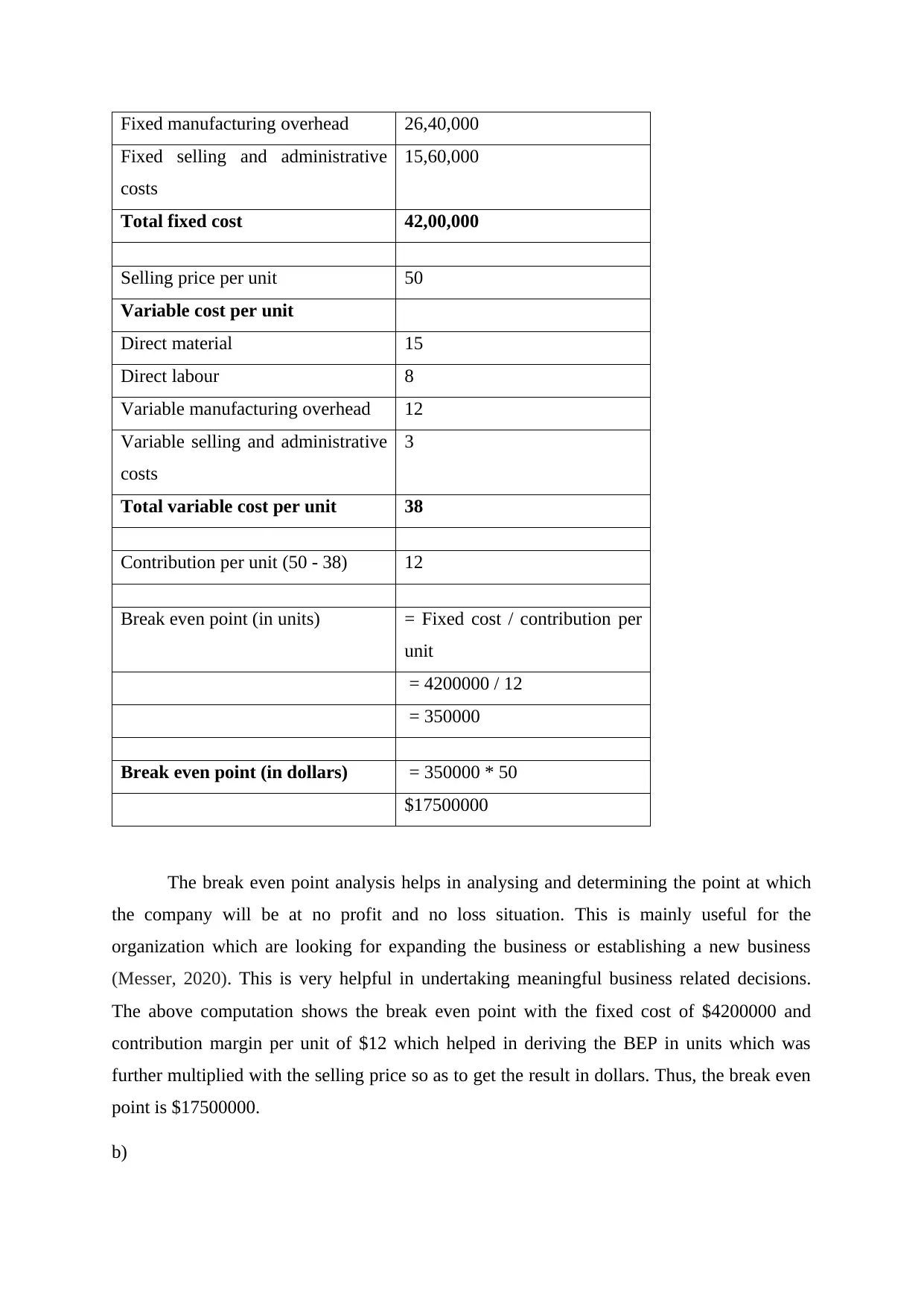
Fixed manufacturing overhead 26,40,000
Fixed selling and administrative
costs
15,60,000
Total fixed cost 42,00,000
Selling price per unit 50
Variable cost per unit
Direct material 15
Direct labour 8
Variable manufacturing overhead 12
Variable selling and administrative
costs
3
Total variable cost per unit 38
Contribution per unit (50 - 38) 12
Break even point (in units) = Fixed cost / contribution per
unit
= 4200000 / 12
= 350000
Break even point (in dollars) = 350000 * 50
$17500000
The break even point analysis helps in analysing and determining the point at which
the company will be at no profit and no loss situation. This is mainly useful for the
organization which are looking for expanding the business or establishing a new business
(Messer, 2020). This is very helpful in undertaking meaningful business related decisions.
The above computation shows the break even point with the fixed cost of $4200000 and
contribution margin per unit of $12 which helped in deriving the BEP in units which was
further multiplied with the selling price so as to get the result in dollars. Thus, the break even
point is $17500000.
b)
Fixed selling and administrative
costs
15,60,000
Total fixed cost 42,00,000
Selling price per unit 50
Variable cost per unit
Direct material 15
Direct labour 8
Variable manufacturing overhead 12
Variable selling and administrative
costs
3
Total variable cost per unit 38
Contribution per unit (50 - 38) 12
Break even point (in units) = Fixed cost / contribution per
unit
= 4200000 / 12
= 350000
Break even point (in dollars) = 350000 * 50
$17500000
The break even point analysis helps in analysing and determining the point at which
the company will be at no profit and no loss situation. This is mainly useful for the
organization which are looking for expanding the business or establishing a new business
(Messer, 2020). This is very helpful in undertaking meaningful business related decisions.
The above computation shows the break even point with the fixed cost of $4200000 and
contribution margin per unit of $12 which helped in deriving the BEP in units which was
further multiplied with the selling price so as to get the result in dollars. Thus, the break even
point is $17500000.
b)
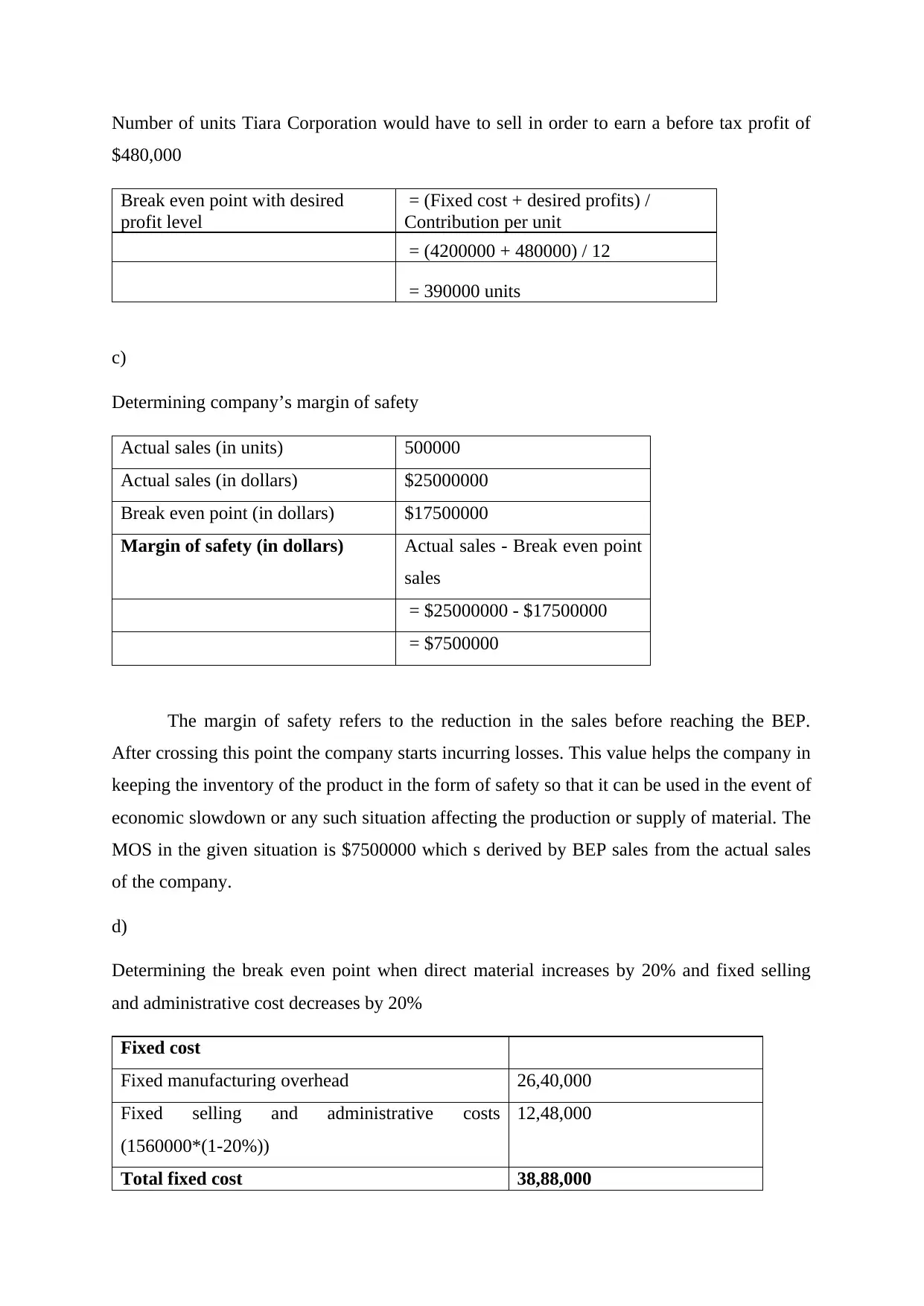
Number of units Tiara Corporation would have to sell in order to earn a before tax profit of
$480,000
Break even point with desired
profit level
= (Fixed cost + desired profits) /
Contribution per unit
= (4200000 + 480000) / 12
= 390000 units
c)
Determining company’s margin of safety
Actual sales (in units) 500000
Actual sales (in dollars) $25000000
Break even point (in dollars) $17500000
Margin of safety (in dollars) Actual sales - Break even point
sales
= $25000000 - $17500000
= $7500000
The margin of safety refers to the reduction in the sales before reaching the BEP.
After crossing this point the company starts incurring losses. This value helps the company in
keeping the inventory of the product in the form of safety so that it can be used in the event of
economic slowdown or any such situation affecting the production or supply of material. The
MOS in the given situation is $7500000 which s derived by BEP sales from the actual sales
of the company.
d)
Determining the break even point when direct material increases by 20% and fixed selling
and administrative cost decreases by 20%
Fixed cost
Fixed manufacturing overhead 26,40,000
Fixed selling and administrative costs
(1560000*(1-20%))
12,48,000
Total fixed cost 38,88,000
$480,000
Break even point with desired
profit level
= (Fixed cost + desired profits) /
Contribution per unit
= (4200000 + 480000) / 12
= 390000 units
c)
Determining company’s margin of safety
Actual sales (in units) 500000
Actual sales (in dollars) $25000000
Break even point (in dollars) $17500000
Margin of safety (in dollars) Actual sales - Break even point
sales
= $25000000 - $17500000
= $7500000
The margin of safety refers to the reduction in the sales before reaching the BEP.
After crossing this point the company starts incurring losses. This value helps the company in
keeping the inventory of the product in the form of safety so that it can be used in the event of
economic slowdown or any such situation affecting the production or supply of material. The
MOS in the given situation is $7500000 which s derived by BEP sales from the actual sales
of the company.
d)
Determining the break even point when direct material increases by 20% and fixed selling
and administrative cost decreases by 20%
Fixed cost
Fixed manufacturing overhead 26,40,000
Fixed selling and administrative costs
(1560000*(1-20%))
12,48,000
Total fixed cost 38,88,000
⊘ This is a preview!⊘
Do you want full access?
Subscribe today to unlock all pages.

Trusted by 1+ million students worldwide
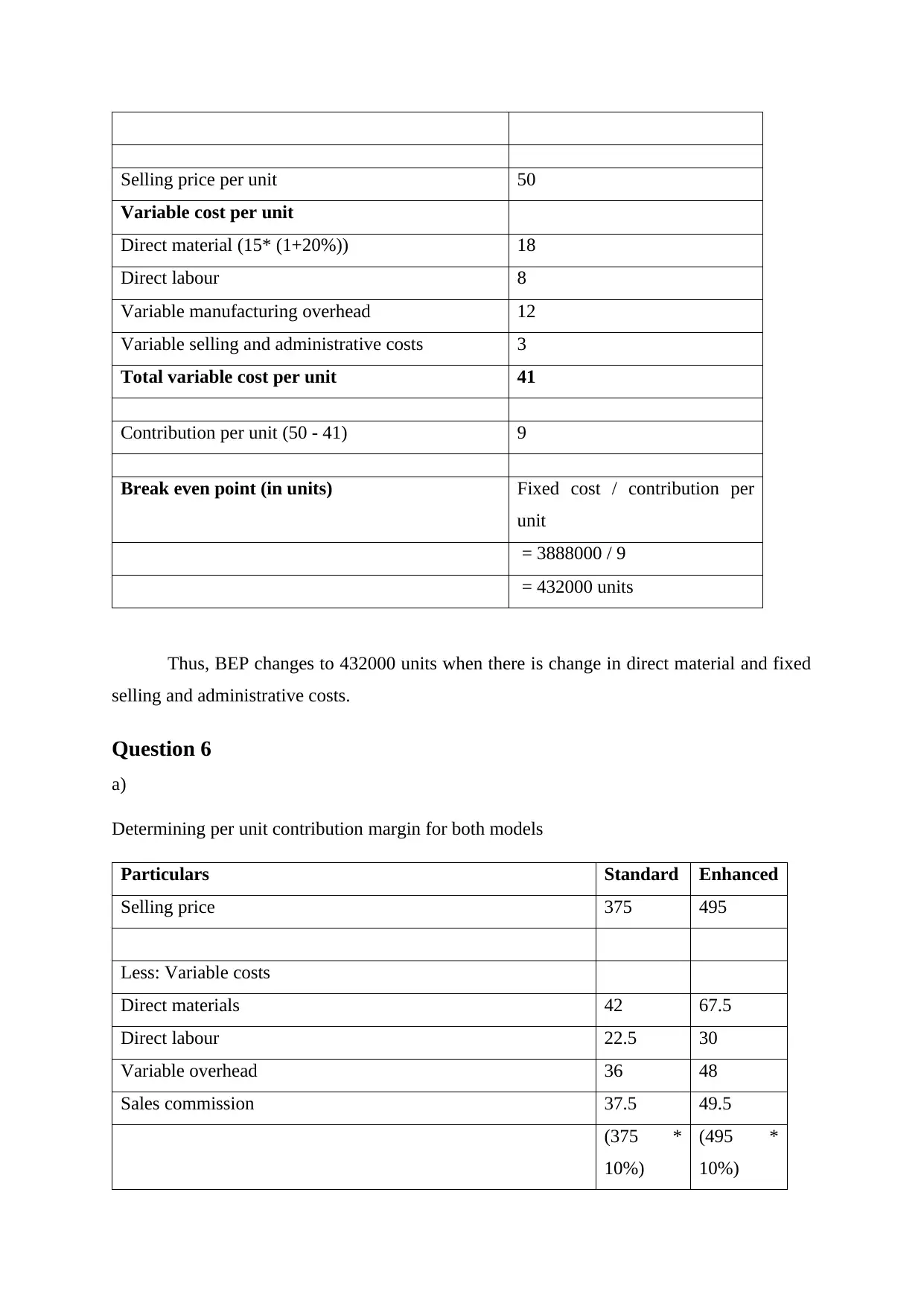
Selling price per unit 50
Variable cost per unit
Direct material (15* (1+20%)) 18
Direct labour 8
Variable manufacturing overhead 12
Variable selling and administrative costs 3
Total variable cost per unit 41
Contribution per unit (50 - 41) 9
Break even point (in units) Fixed cost / contribution per
unit
= 3888000 / 9
= 432000 units
Thus, BEP changes to 432000 units when there is change in direct material and fixed
selling and administrative costs.
Question 6
a)
Determining per unit contribution margin for both models
Particulars Standard Enhanced
Selling price 375 495
Less: Variable costs
Direct materials 42 67.5
Direct labour 22.5 30
Variable overhead 36 48
Sales commission 37.5 49.5
(375 *
10%)
(495 *
10%)
Variable cost per unit
Direct material (15* (1+20%)) 18
Direct labour 8
Variable manufacturing overhead 12
Variable selling and administrative costs 3
Total variable cost per unit 41
Contribution per unit (50 - 41) 9
Break even point (in units) Fixed cost / contribution per
unit
= 3888000 / 9
= 432000 units
Thus, BEP changes to 432000 units when there is change in direct material and fixed
selling and administrative costs.
Question 6
a)
Determining per unit contribution margin for both models
Particulars Standard Enhanced
Selling price 375 495
Less: Variable costs
Direct materials 42 67.5
Direct labour 22.5 30
Variable overhead 36 48
Sales commission 37.5 49.5
(375 *
10%)
(495 *
10%)
Paraphrase This Document
Need a fresh take? Get an instant paraphrase of this document with our AI Paraphraser
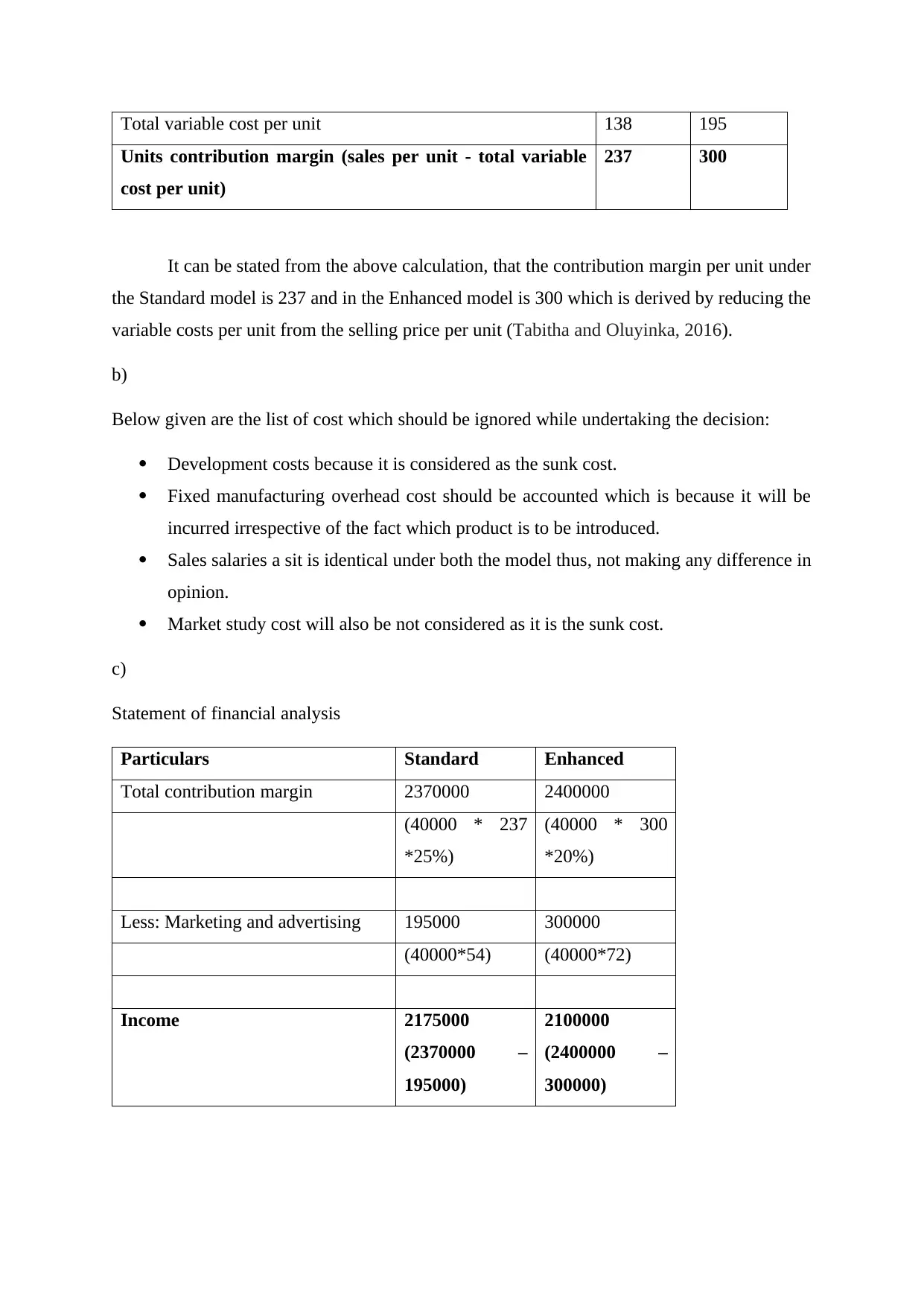
Total variable cost per unit 138 195
Units contribution margin (sales per unit - total variable
cost per unit)
237 300
It can be stated from the above calculation, that the contribution margin per unit under
the Standard model is 237 and in the Enhanced model is 300 which is derived by reducing the
variable costs per unit from the selling price per unit (Tabitha and Oluyinka, 2016).
b)
Below given are the list of cost which should be ignored while undertaking the decision:
Development costs because it is considered as the sunk cost.
Fixed manufacturing overhead cost should be accounted which is because it will be
incurred irrespective of the fact which product is to be introduced.
Sales salaries a sit is identical under both the model thus, not making any difference in
opinion.
Market study cost will also be not considered as it is the sunk cost.
c)
Statement of financial analysis
Particulars Standard Enhanced
Total contribution margin 2370000 2400000
(40000 * 237
*25%)
(40000 * 300
*20%)
Less: Marketing and advertising 195000 300000
(40000*54) (40000*72)
Income 2175000
(2370000 –
195000)
2100000
(2400000 –
300000)
Units contribution margin (sales per unit - total variable
cost per unit)
237 300
It can be stated from the above calculation, that the contribution margin per unit under
the Standard model is 237 and in the Enhanced model is 300 which is derived by reducing the
variable costs per unit from the selling price per unit (Tabitha and Oluyinka, 2016).
b)
Below given are the list of cost which should be ignored while undertaking the decision:
Development costs because it is considered as the sunk cost.
Fixed manufacturing overhead cost should be accounted which is because it will be
incurred irrespective of the fact which product is to be introduced.
Sales salaries a sit is identical under both the model thus, not making any difference in
opinion.
Market study cost will also be not considered as it is the sunk cost.
c)
Statement of financial analysis
Particulars Standard Enhanced
Total contribution margin 2370000 2400000
(40000 * 237
*25%)
(40000 * 300
*20%)
Less: Marketing and advertising 195000 300000
(40000*54) (40000*72)
Income 2175000
(2370000 –
195000)
2100000
(2400000 –
300000)
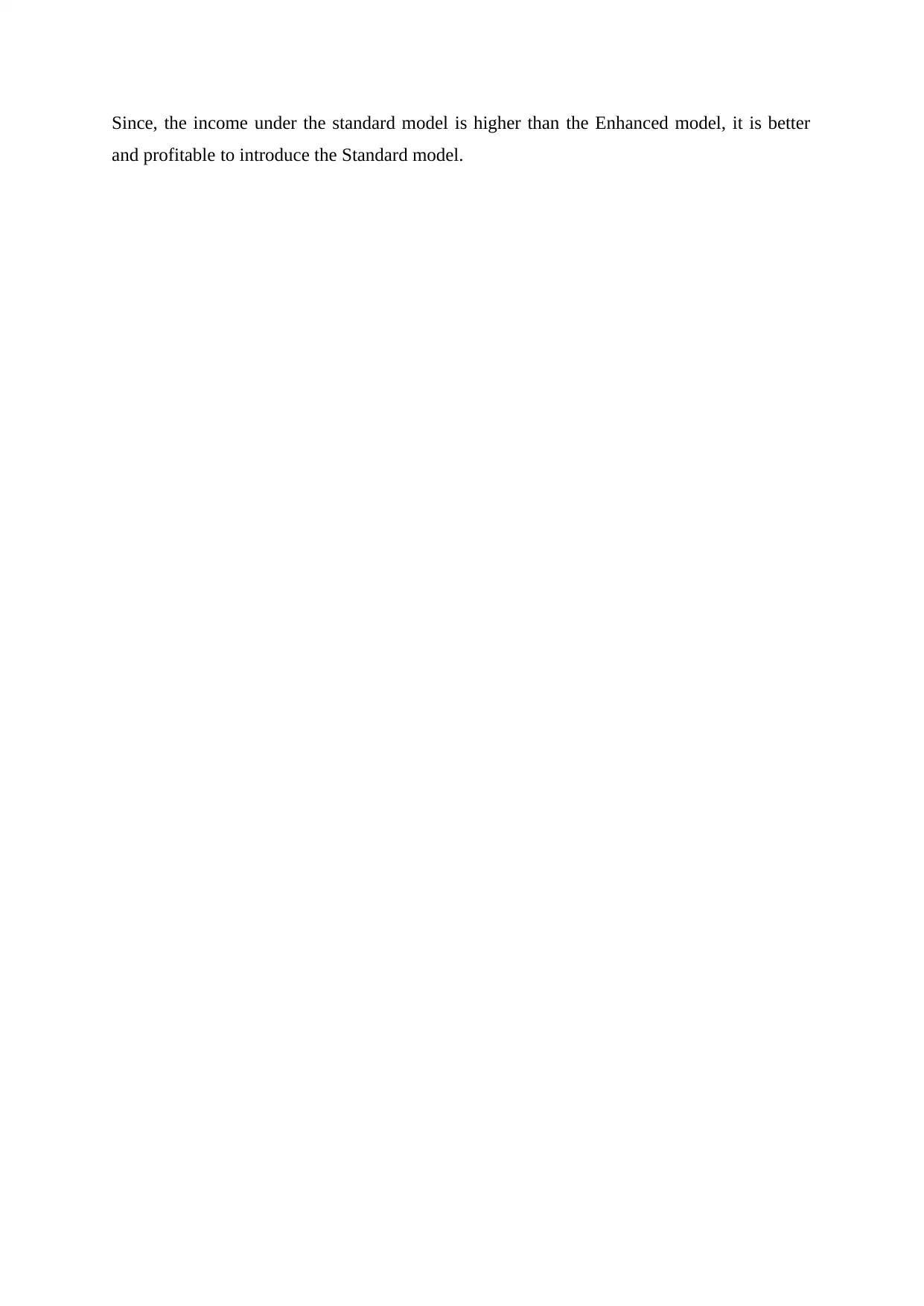
Since, the income under the standard model is higher than the Enhanced model, it is better
and profitable to introduce the Standard model.
and profitable to introduce the Standard model.
⊘ This is a preview!⊘
Do you want full access?
Subscribe today to unlock all pages.

Trusted by 1+ million students worldwide
1 out of 13
Related Documents
Your All-in-One AI-Powered Toolkit for Academic Success.
+13062052269
info@desklib.com
Available 24*7 on WhatsApp / Email
![[object Object]](/_next/static/media/star-bottom.7253800d.svg)
Unlock your academic potential
Copyright © 2020–2025 A2Z Services. All Rights Reserved. Developed and managed by ZUCOL.





